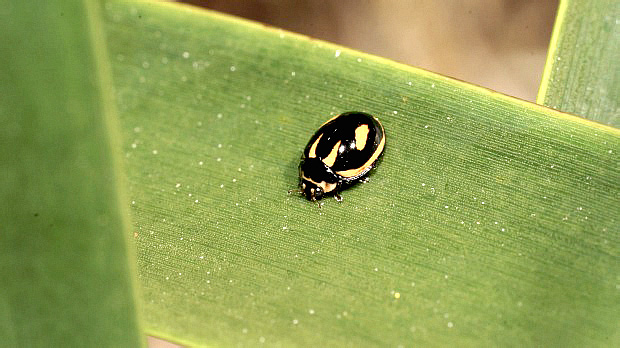
|

|



|
|
Австралийский программист и фотограф-любитель Reiner Richter
нашел на юге Австралии коровку Micraspis flavovittata -
вид, который давно уже считался исчезнувшим.
Любитель нашел около 40 экземпляров этого небольшого (5 мм длиной) жука.
Текст и иллюстрации заимствованы на сайте WWW.SMH.COM.AU

Amateur photographer Reiner Richter discovered the elusive ladybird (Photo: Jason South) |

The marsh at the Discovery Bay Coastal Park the ladybird was found (Photo: Reiner Richter) |

Wily one: the rediscovered ladybird, Micraspis flavovittata (Photo: Reiner Richter) |

Map of the place of observation |
By Bridie Smith
An Australian ladybird beetle scientists presumed extinct for decades has come "back from the dead" after an amateur naturalist spotted more than 40 of the yellow and black bugs at a national park in western Victoria.
The find not only returns the beetle to the list of the living, it's also likely to prove scientifically significant. This month's sighting was almost 500 kilometres west of the only places the beetle has been previously found, in Narbethong and Kallista. The new site could provide an insight into why the ladybird went extinct at the original sites.
A computer programmer by trade, amateur naturalist Reiner Richter admits he originally pulled on his gumboots last week to search for rare dragonflies at a marsh in the aptly named Discovery Bay Coastal Park, west of Portland.
"I saw these ladybirds and thought they looked interesting," Mr Richter said. "I knew I hadn't seen them before but I assumed I'd go back and find them on the CSIRO website. But I couldn't find them on there."
He uploaded his photographs to the citizen science website Bowerbird, where Museum Victoria's senior curator of entomology Ken Walker spotted them.
However the tiny beetle, measuring no more than 5mm, initially confused Australian experts. CSIRO beetle evolution and classification expert Adam Slipinski, unable to match the photograph to any beetle on the agency's Canberra database, concluded it must be an introduced species.
Just to be sure Dr Walker forwarded the photograph to global beetle expert Roger Booth at London's Natural History Museum.
On Monday, news came through that it was indeed a Micraspis flavovittata, a predominantly black ladybird with a yellow trim around the base and yellow markings on the middle of the back and near the antennae. The ladybird has not been seen since 1940.
"It's really, really special to find something that we presumed was extinct and then through a non-scientist, it pops up and the scientists go 'wow'," Dr Walker said.
There are 70 known ladybird species in Australia. The reason Dr Slipinski couldn't identify it was because the CSIRO collection didn't hold a specimen. Indeed, there are just four known specimens in scientific collections worldwide: two at the Natural History Museum in London and two at Museum Victoria.
Dr Walker said that when the beetle was first described in 1874, its numbers were thin on the ground.
The two museums, as well as the CSIRO, are now clambering to get more specimens in their collections.
Dr Walker said the new site so far west of the species' known range would likely prove illuminating.
He said it would be worth comparing the Narbethong and Kallista habitat with the marsh area the beetle was found in. This might explain what led to the insect's disappearance locally.
"It could be urbanisation, it could be pesticide usage or it could be agricultural usage," he said. "And of course these things are food for birds Е so for the benefit of the ecosystem, it's good to know what is going on."
Mr Richter said he counted about 40 of the beetles in the area, the majority of them on the long slender leaves of the water-ribbons plant. Dr Walker said the numbers represented a thriving population.